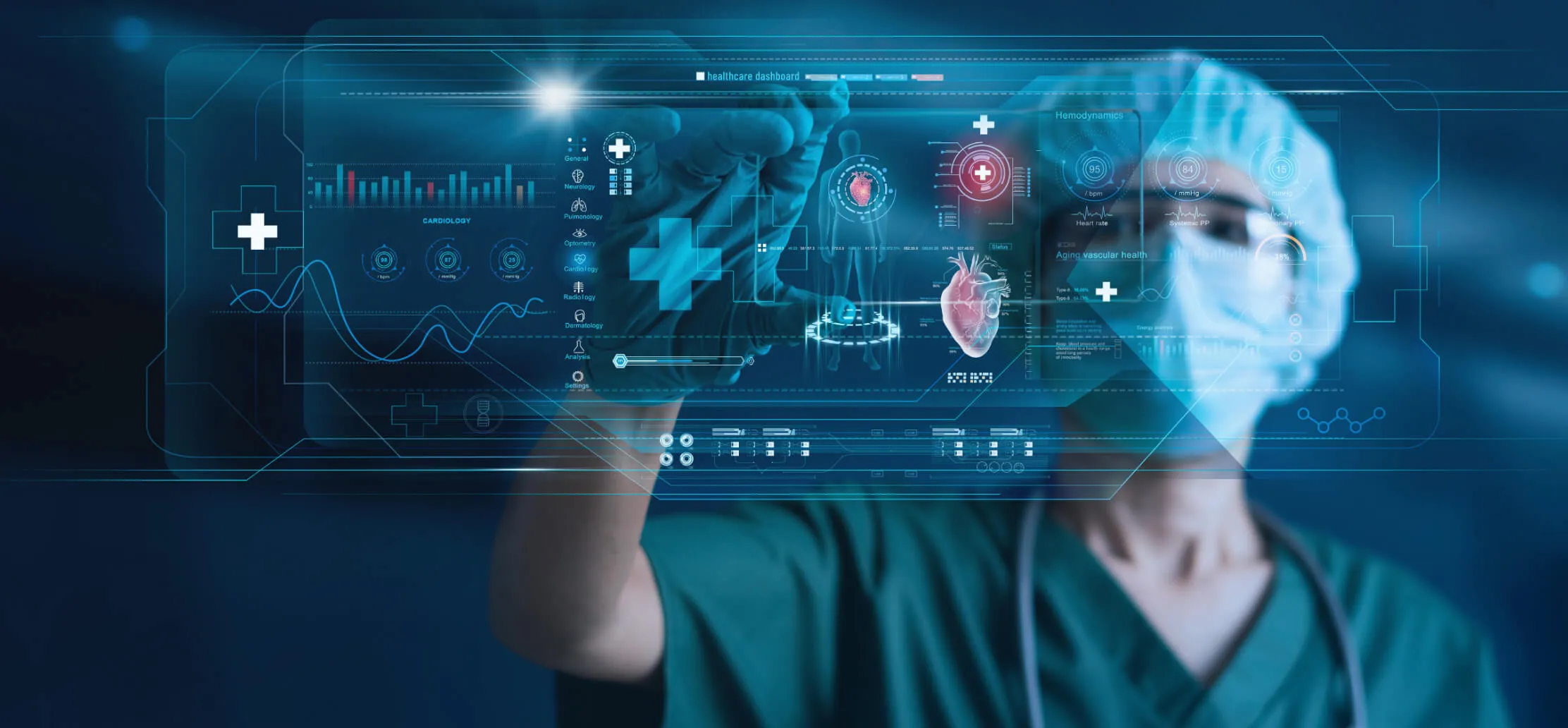The Emergence Of VR/AR In Healthcare Is Transforming Surgical Procedures

Digital transformation in healthcare has led to countless opportunities and advancements, which were once alienated from humankind. From something as basic as keeping records to managing complex surgeries, it has come a long way.
One of the aspects of digital transformation in healthcare is the introduction of Virtual Reality (VR) and Augmented Reality (AR). Let us have a look at how the concept of digital transformation in healthcare with AR/VR for medical surgeries originated. And how it is making its place in the world of modern healthcare solutions.
Need For VR/AR In Surgeries
A few years back, it was nearly impossible to detect a severe illness in the early stage, let alone make a virtual image of the infections spreading in someone’s body. But, now it is possible, thanks to VR and AR technology.
AR and VR, which were initially introduced in the world of gaming and PlayStations have made their way into healthcare as well. Now, it is possible to build a virtual image of any infection, be it in the brain or lungs, or any other part of the body, it can be detected easily. Such a development is beneficial for both doctors and patients.
It helps the patients to get familiarized with their illness and understand their situation better. Also, it helps them to let go of the fear of the unknown and get into surgery with a more positive outlook.
It allows the doctors to map out the situation better. They can see for themselves if the situation is critical or not and what necessary steps they must take. Risks in surgery can be minimized with VR/AR tools mimicking the actual surgery using 2D and 3D imaging.
How Can AR/VR Provide Solutions In Case Of Surgeries
Visualization: The introduction of VR and AR in surgery can provide a whole new level of interaction with human anatomy. For places with limited access to cadaver resources, this is a major development.
VR devices can provide a 360-degree view and allow the surgeon to compare different images together. This will help in improving the precision and accuracy of the surgical process. Just like visualization in 3D CT and MRI scan helps in knowing the severity of fractures, VR can help with critical surgeries.
With AR, a direct view of the spatial anatomy of the body can be created by superimposing the radiological images over it. This would help make the diagnosis process better and more efficient. It can also be used along with haptic technology to recreate surgical procedures. This will allow the surgeon to analyze the procedure in more detail, thereby increasing accuracy and precision.
Training: VR can be a very beneficial training tool for surgeons. It is convenient and reduces the chances of surgeons feeling unprepared. And, can also help in making the whole training process more objective.
Unlike the practice of going on a two-to-three-day training period, surgeons can train as per their schedule. This allows greater flexibility and directly targets the skill gap by providing the required training. Doing so can increase their confidence when it comes to performing complex surgeries.
Surgeons can create a virtual surgical environment similar to the actual one to get hands-on training at their convenience. Also, by using VR-based tools, one can easily take the process out of the subjective behavior of humans. It is an important aspect as it can provide accurate and unbiased critique regarding surgical proficiency.
Collaboration: Expert opinions can be taken from senior surgeons regardless of their availability. This is possible with the help of telementoring which uses VR and telecommunication technology. Real-time virtual surgical field can be shared with the seniors or an expert surgeon to get their feedback.
Telementoring is the safer and better alternative as it reduces the chances of mismanagement, and doesn’t require unnecessary patient transfer. It also provides a better space for discussions regarding the best possible solution.
Planning: VR and AR have made 3D imaging and virtual surgical process possible. Because of this, surgeons can look at the root cause of the problem in real-time. They can then discuss it with experts virtually. This gives them clarity, and allows them to discuss the different surgical approaches with the possible pros and cons in mind.
Thorough planning allows the surgeons to discuss all the details with the patient with more clarity. Thereby, helping the patient to take the next step with a complete understanding of what they are signing up for. It also allows the surgeon to test different approaches on the virtual scene. It gives them an idea as to how the negatives and positives of that particular approach weigh.
When the extent of the particular infection or disease can be seen in clear form, it leads to better planning of which approach to choose. Be it medication or the kind of surgical procedure to select, it helps in better decision-making.
Implementing AR/VR as healthcare solutions can be a critical step. It involves the right set of steps for the business. Our team is well-equipped and skilled to help your business set up a top-notch system.
AR And VR Tools Used In The Surgeries
Surgical Robots – Unlike humans, robots can perform surgeries with more precision and efficiency. One example of a surgical robot is Da Vinci System which was introduced almost two decades ago. With its 3D imaging and tiny wristed instruments, it was a revolutionary development in the field of surgical procedures.
However, these robots are to supplement the humans, not take their jobs. These robots work under human supervision and are controlled by them only. These surgical robots add the value to already existing expertise of the surgeon by being more precise when dissecting, stitching, and retracting tissues.
After seeing such a positive response from the semi-automated robot system, it can be said that there’s definitely a place for robots in the field of surgery. However, the real breakthrough would be when the whole surgical process is completely automated, regardless of the complexity.
Smart Glasses – Smart glasses are like small computers which are attached to a head-mounted monitor and headgear. This can be useful in two ways.
It helps with the training process as the trainees can record and understand the procedure from the perspective of the person performing the surgery.
This can be really beneficial to those learning via virtual platforms. Trainees can take advantage of the virtual surgical setup and understand the whole process from a first-person perspective. To be able to see all the steps in depth without cramming around the patient is an added bonus.
Smart glasses can help in keeping and tracking patient records. Having a patient’s history and other records can help in the decision-making process.
Electrosurgical Technologies – Electrosurgery is using electromagnetic current on dissected tissues to generate heat. It can vary depending on the waveform, power, and surgical process used. Electrosurgery is generally used to control the bleeding and to dissect the tissues faster.
This technology is beneficial, however, it also releases harmful smoke. Smoke pencils and other smoke removal tools have become common in the surgical room because of how efficient electrosurgical technology is.
Virtual Reality Surgical Planning – The 3D printing technology along with VR has been of great help to surgeons. Complicated and high-risk level surgeries require thorough planning. Surgeons can easily use the combination of the two to create the structure of human bones, muscles, blood vessels, etc.
It allows the surgeons to understand the technicality and human body structure. With that, how to go about the surgical procedure can be planned and organized. With the advancement in 3D printing technology, the in-depth understanding of anatomy and pathology has increased. This further helps in improving the trainee’s skillset and confidence.
Advantages of VR In Surgery
- AR and VR technology provide a detailed visualization of the surgical process, thereby helping to improve precision and accuracy.
- It allows the surgeon to practice the procedures in a virtual environment which helps in upgrading their skills and reducing the chances of errors.
- VR can facilitate communication between surgeons. It creates a platform for efficient consultation and getting a second opinion regardless of where they are in the physical environment.
- Practicing in the virtual surgical setup reduces the time and cost during the actual surgery.
- VR creates an interactive visual representation of whatever the problem is. This allows the patient to understand the situation better and control anxiety.
AR and VR are indeed major advancements when it comes to digital transformation in healthcare. It has opened the gates for new opportunities and brought in the necessary changes. From increased precision to enhanced systems of training and communication, it is changing everything as a whole.
Currently, surgical robots are working under human supervision. However, this means that in the future, everything would be fully automated. It would be truly revolutionary.
Technological advancement is not only making the process more convenient for the surgeons, but it is also allowing the patient to become a part of how all the procedures are occurring. It has led to better communication between both patients and surgeons as well and not just between two experts.
To make the most out the AR/VR healthcare solutions, the best & right system needs to be in place. The team of TRooTech gives attention to detail to ensure that everything is in place and in the system.

